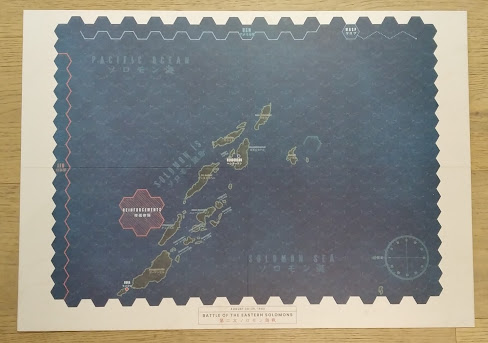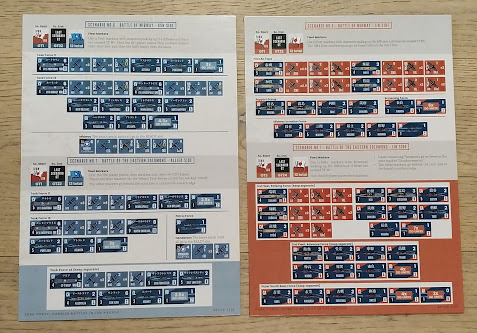I like
YouTube for the wargame content that’s available these days. I don’t aspire
have my own YouTube channel. I’ll leave that up to the extroverts. I am, however, really grateful for the unboxings, rules tutorials and playthroughs you find
there.
So,
here I want to try something different; a new article type that looks at the
materiel of games. Kind of like an unboxing, but without the misguided
commentary that sometimes accompanies an unboxing video. Just the best pictures
I can manage with my cheap-ass phone, and maybe a few words about the quality of
the components and such. If it works, I might even invest in a better camera.
So, without further ado, let’s take a look at Vuca Simulations’ Task Force: Carrier Battles in the Pacific (2023).
.jpg) |
| Now, that's some really lovely cover art. |
Task Force is a reprint of a Japanese naval battle
game designed by Ginichiro Suzuki and first published
in that country in 1982. Vuca is starting to demonstrate that there is a strong
market for updated versions of older games that haven’t necessarily had their
moment in the sun for Western audiences.
 |
| I love the Vuca era-scale that features on all their games. |
Task Force comes in a three-inch box and it needs
every bit of that space. With the exception of the map for the first Scenario,
Attack on Pearl Harbor, all the map-boards are mounted (double-sided), as are
the two player task force displays, and the land base display; even the player’s
aids are printed on pretty solid card-stock. The game also comes with six counter sheets, all on thick card-stock (and all
pre-rounded).
 |
| Lots of ships, lots of planes. |
The ship counters are elongated rectangles boasting a bird’s eye view of the ship with its name in Roman and Kanji scripts, surrounded by its numerical values and letter-designation (BB for battleship, CV for Carrier, CL for heavy cruiser, etc.). A coloured corner swatch on the top right corner indicates the ship’s nationality. Along with the ships of the United States Navy (USN) and Imperial Japanese Navy (IJN), a respectable showing of vessels from the United Kingdom, the Netherlands, and Australia are presented.
The game comes with two books; the 20-page rulebook and a 28-page scenario book. Following what is (I think) best practice in games with innovative rules or novel ideas, the first three scenarios are solo teaching scenarios with the fourth being a two-player rules-teaching match.
Scenario 1 – Attack on Pearl Harbor, is basically a snapshot of the attack on the ships anchored by or near Ford Island, and serves to demonstrate in an instructive way how the air attack rules work. Because you’re unlikely to place this more than twice, the Vuca folks made the sensible choice to put this map on (very good quality) paper.
 |
| Attack on Pearl Harbor (obviously). |
The remaining seven scenarios are a mix of historical
and speculative situations, increasing in complexity. The Scenario book also
has advice and tables for creating your own balanced scenarios using the
available components.
 |
| Battle of the Java Sea |
 |
| Combined Fleets scenario (kind of a speculative naval Battle Royale). |
 |
| Sinking of the Prince of Wales and Repulse (Solitaire scenario). |
The remaining maps are mounted on sturdy board-stock, one 11” by 17”, and two 17” by 22”. These are where the tactical game plays out. The scale of the ocean maps is 75 miles to a hex, and the task forces appearing in a scenario are represented on the board by a TF marker. The fog of war is represented by other dummy TF markers. Part of the fun of the game is trying to identify your opponent’s real task forces before they can identify yours.
 |
| Battle of the Eastern Solomons |
 |
| Battle of the Coral Sea |
 |
| Battle of Midway |
The maps
are beautifully presented. The colour chosen for the ocean looks right for the Pacific,
a richly dark, green-tinged blue that evokes the deep, deep water of the open sea.
There are five double-sided scenario
set-up charts to help you identify the ships. Planes and markers you’ll need
for each scenario.
This isn’t a new thing, but I’m always
happier to see it in a new game. While it’s double handling, I find it actually
cuts down the prep time by a significant factor.
You set out all the units before transferring
them to the Task Force Display boards. Turns are tracked on a slender two-day mounted turn-track.
 |
| From the top: USN TF display; IJN TF display; Turn tracker (eight day turns, four night turns - most scenarios don't run more than a day or two).. |
 |
| Land base display. |
.jpg) |
| The counters have a shiny linen finish that make them pop on the board, but they're terrible to try to photograph, |
But the heart of the game is the PACs.
These are, again, mounted on good, firm card-stock. They are double sided, easy
to read, and the contain everything you’ll mee dot play the game.
 |
| Seriously, one of the most well-designed PACs I've ever seen. |
These photos don’t do justice to the
quality of the materials in Task Force. A lot of attention has been given to
every aspect of the game’s presentation. The rules are well laid out, presented
in a sensible order, and with only a little duplication. The same with the
scenarios, which all come with brief historical notes and sensible advice. The
only thing I could possibly gripe about would be the size of the font; it's a blocky serif font that is perfectly
readable in the maybe nine-point it's been printed in, but I tend to complain like a restaurant critic if I have to reach for my reading glasses, so
that one’s on me.
The ship counters are lush, with the battleships
cruisers and carriers all getting their own individual representations. The
destroyer counters all look the same but that is perfectly forgivable. The
plane counters are a tad more functional, but the little silhouettes of the
aircraft are clearly representative of the plane in question – you can tell a Zero
from a Kate from a Val by the image alone. The markers are functional as well,
but all have some small flourish that adds to the charm of the game. It’s a
spectacularly gorgeous package.
The artwork on the box-lid and the two
booklet covers also warrants a mention. The simple, screen-printed style evokes
a poster style from the era. It’s becoming something of a trademark look for
Vuca Simulations, and I think it really works for WWII games generally, certainly
in this case.
I hope this has been an interesting
tour through the contents of Task Force: Carrier Battles in the Pacific. It’s
not something I intend to do with every game that passes through my hands, but I
already have the next one or two in mind for this treatment.
Thanks for reading all the way to the end.












No comments:
Post a Comment